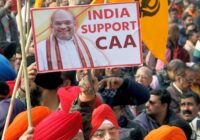Over the past five years, India has seen several changes around the creation and dissemination of data. The Indian government has come under fire for withholding data on crucial issues like unemployment, as well as changing statistical methodologies to ascertain key metrics, calling into question the reliability of the source data itself.
In a country of 1.3 billion people, over half a billion internet users and more than 400 TV channels, a lack of reliable information is a serious problem. Not only do poor journalistic standards and ethics drive mass disinformation along political lines, but the increasingly widespread use of social media exacerbates the country’s social and sectarian divides. According to a report by IndiaSpend, at least 24 people have been killed in 2018 alone by lynch mobs angered by fake social media stories. Analysis by the BBC has similarly documented a sharp increase in fatal mob attacks in 2018.
The situation is exacerbated by the fact that the number of WhatsApp users alone is predicted to reach a whopping 450 million this year — up from 200 million in 2017. According to Digital Trends, WhatsApp “dominates India’s digital channels of communication,” spanning e-commerce, entertainment, news and more, and has become a breeding pool for misinformation. While the company has started putting measures in place to curb the spread of fake news, launching radio campaigns to alert users to the potential consequences and shutting down 2 million accounts each month, but so far these efforts have not had any significant effect.
At a time when distinguishing news from misinformation is difficult or even impossible, and source data is under attack, projects like IndiaSpend and DataBaaz aim to challenge the status quo through data-based journalism. Supported by the Google News Initiative, they address critical issues like gender, health care and education through data-based stories and videos.
In this edition of The Interview, Fair Observer talks to Govindraj Ethiraj, the founder of IndiaSpend and DataBaaz, about how the two companies use data to tell stories that matter, and how Indians can learn to spot fake news.
The text has been lightly edited for clarity.
Ankita Mukhopadhyay: Can you tell us a bit about IndiaSpend and DataBaaz?
Govindraj Ethiraj: I launched IndiaSpend.com to tell stories through data, while DataBaaz is a video platform. Our focus is primarily gender, health, education and environment, as these issues underpin the economic and social development of any country. We believe that if there is a basic understanding of issues like health and gender, then we can make these issues our focus when we interact with our elected representatives and press for change where it’s necessary.
IndiaSpend has been around for seven years and is a business-to-business [B2B] service. Our content goes to publishing partners like newspapers, online dailies, wire services and television. It’s also read by people in academia and government, which is an influential audience, but not a large audience.
We want to reach out to more people, particularly young people. With young people, we face the challenge of making them data-aware. The India Fact Quiz is a device to tackle this challenge. The quiz, which creates a gamified environment, will reach out to more people and get them engaged. Young people also get an opportunity to win prizes.
Mukhopadhyay: What is the objective of the India Fact Quiz? Why is there a focus on individuals between the ages of 17 and 25?
Ethiraj: The India Fact Quiz aims to create awareness among India’s youth about data literacy. The quiz also aims to encourage fact-checking of information on India, against the backdrop of the UN’s Sustainable Development Goals. The idea is to test and challenge the mental biases and myths around India, by providing correct data and facts to participants. We want to encourage our youngsters to have a more factful view of the world. The India Fact Quiz will identify India’s curious and most factful minds, who value the importance of data in public discourse and create a new wave of factful citizen-engagement.
India Fact Quiz will be a pan-India quiz and is designed in a digitally gamified quizzing format which connects with today’s youth. The digital quiz will run online for 30-45 days, followed by physical rounds, which will be held at five colleges at different parts of the country … and broadcast on television. Subsequently, there will also be weekly online quizzes on the India Fact Quiz website to continue encouraging the practice of learning and fact-checking.
Mukhopadhyay: Your primary focus over the last few years is to bring data-based insights and journalism to the Indian masses. Why did you make the shift from broadcast journalism to data-based storytelling?
Ethiraj: My last job was with Bloomberg. I have spent about 10 years in print, 10-11 years in television and then moved to digital. I have been a financial journalist all my life, analyzing companies and their performance. I always felt that there was an opportunity to apply my skills of analyzing data to issues of larger public interest.
That’s why I made the shift to data-based journalism. I was also partly influenced by the Anna Hazare movement in 2011. The movement was counterintuitive to what people in my generation assumed about millennials — that they are not interested to be part of the active political process. The Anna Hazare movement showed us that young people are not dismissive of politics. The point was made. At that time, I thought, If there is emotion about change, then can we bring data into the equation? If you blend data with emotion, then people will hopefully ask the right questions and demand higher quality of governance and accountability.
Mukhopadhyay: A challenge students, journalists, companies and other enterprises in India face is both the lack of, and slow access to, information. How do you tackle this?
Ethiraj: Over the last five years, the data landscape has changed. There is an oversupply of data, but not much demand for the data. But a problem that’s arisen in the past few years is that government is revisiting data sets and pulling them back. This has happened with employment data and consumption data, which is going back and forth. It’s a new kind of problem which wasn’t there earlier. We are still figuring out how to respond.
At the end of the day, only a government can collate such a huge chunk of data. Private players can’t do it, so you depend on the government. But if the source data is being changed, what do we do? To respond to that, we first need to wrap [our heads] around data that exists, how to use it effectively to ask questions.
Mukhopadhyay: You mentioned that some of the data is being revisited. How do you tell the stories in this scenario?
Ethiraj: We don’t. We avoid writing on topics like consumption or unemployment. Our primary focus is health, environment and gender. We don’t write on issues like job creation. We touch on different aspects of the issue, like women dropping out of the workforce. We are not set up to court controversy or take on the government. Our mission is to tell stories through data. In circumstances where data is pulled out for political reasons, we avoid getting involved in those topics.
Mukhopadhyay: Indian journalism is currently undergoing a transition following the rise of digital media. How has the role of Indian media changed, particularly in disseminating information to the public?
Ethiraj: I don’t think the role of Indian media has changed, but it needs to change. I would frame the statement in that way. As a media executive, one constantly asks, What is my role? My role is to inform, educate and make people aware of what is happening around them in an objective way. I am not sure if a lot of journalistic organizations fulfil that basic tenet — and that’s because they operate like any other business. But if you operate media like a business, the product suffers.
When It Comes to Mental Health, India Remains Shockingly Misinformed
Take television for instance. Owing to oversupply and competition, TV channels do essentially anything to orient their product so that it appeals to audiences. Such viewpoints are usually extreme or champion a certain viewpoint over others. The executive producer sitting in a TV room has a single objective — to beat last week’s ratings. Which is not philosophically wrong, but it is what you do to get that rating that makes everything a game. Most people lose sense of their moral compass.
Television is a soft power, but it causes far more damage than good in India. It’s a business-model failure because of oversupply. You have over 400 channels when there should be 40, which causes everyone to go berserk.
Mukhopadhyay: At a time when misinformation spreads rapidly, particularly on social media, how can Indians access the facts and distinguish between information and misinformation?
Ethiraj: This is a tough question. There is no way to say that the data you’re giving is more accurate than the data that I am giving. And it’s tougher to make that distinction, as most of us have our prejudices and therefore only trust some things because we like the look of it. The only thing people can do is be more vigilant and alert and careful about how they form opinions from the information they get. One should try to form specialist resources of their own.
For example, if you like to follow what’s happening in medicine, then follow the American Journal of Medicine, or Science Daily. At least you know that if there’s research that’s being talked about, then there are people who know what they are talking about. People have to be more vigilant, do their own research and not let emotion drive them. It’s a tough call, and it’s not easy.
I think we should create a culture of appreciation of data and where data comes from. For example, if I quote the second most populous state, that data will come from the census. Whichever side you’re on — left or right — when you use data, debates become rational.
Mukhopadhyay: In the past few years, public faith in data provided by news organizations has fallen. Media organizations also quote different figures for the same story. Why has this happened, and how can it be tackled?
Ethiraj: Until last year and the year before that, we had no problem with base data. We never faced a situation where basic data like the gross domestic product growth was questionable. For the first time, the source data is being discredited by the government itself. We are in a strange territory. If one organization says that India is doing well, another one is saying it is not — and both are using the source data. This puts the reliability of the source data into question. For example, India’s former chief economic adviser has said that our GDP growth is 2.5% lower than what is being reported in the media.
Other countries have also gone through such a situation, where their source data was considered unreliable. There was once a lot of suspicion on China’s data. The loss of trust in India’s core data sets is now a fundamental problem. To rectify this, one needs to use a multilateral approach. We have to collectively figure out the best way to create source data sets that people trust.
Mukhopadhyay: How can Indian citizens leverage data to hold politicians accountable for their work?
Ethiraj: If and when Indians imbibe a culture to use data to ask questions, they should hold politicians accountable at a more local level. Do I know the budget of my local member of parliament? What has that person achieved in the last five years? If there is a focus on work at the local level, then the outcome Indians can see from using data is considerably more and precise.
Mukhopadhyay: You mentioned earlier that one of the core topics of IndiaSpend is gender. How can one achieve political change for women through data, when the problems are more deep-rooted within the society and human psyche?
Ethiraj: Our focus is to generate awareness. And awareness leads to greater gender equality. For example, most of us are now aware that if girls are educated, then that fixes a lot of problems in society. Children of educated women are healthier and receive better education. Our objective is to report on issues that are related to gender to better gender outcomes because gender is a foundational thing.
Mukhopadhyay: You recently launched a Hindi version of your website, IndiaSpend.com. Why did you decide to venture into the vernacular medium? What benefit do you see from this diversification?
Ethiraj: We diversified into local languages as we wanted to cater to a larger audience. We also wanted to reach south India, so we started a Tamil version of our website recently. If we get more resources, we will launch another version in the south as well. The idea is that more and more people should read our stuff. I know our stuff in Hindi goes to news desks in Jagran and Dainik Bhaskar [top Hindi-language newspapers in India].
Mukhopadhyay: IndiaSpend has a business-to-business model. Do you plan to convert to a business-to-customer (B2C) model anytime soon?
Ethiraj: Our work is accessible by everyone on our website and social media. However, we haven’t come up with a B2C strategy, as IndiaSpend is not a B2C product by definition. You don’t come to read IndiaSpend unless you’re academically inclined or a public policy enthusiast. In addition, our stories are difficult to read as they use a lot of data and they are not about happy issues. B2C products have to be higher on emotion or entertainment. I have worked at the Times Group for five years, so I have some understanding of what works, and what doesn’t, for consumers. It makes sense if IndiaSpend’s work appears in the Times of India, rather than if it competes with the Times of India.
The views expressed in this article are the author’s own and do not necessarily reflect Fair Observer’s editorial policy.
Support Fair Observer
We rely on your support for our independence, diversity and quality.
For more than 10 years, Fair Observer has been free, fair and independent. No billionaire owns us, no advertisers control us. We are a reader-supported nonprofit. Unlike many other publications, we keep our content free for readers regardless of where they live or whether they can afford to pay. We have no paywalls and no ads.
In the post-truth era of fake news, echo chambers and filter bubbles, we publish a plurality of perspectives from around the world. Anyone can publish with us, but everyone goes through a rigorous editorial process. So, you get fact-checked, well-reasoned content instead of noise.
We publish 2,500+ voices from 90+ countries. We also conduct education and training programs
on subjects ranging from digital media and journalism to writing and critical thinking. This
doesn’t come cheap. Servers, editors, trainers and web developers cost
money.
Please consider supporting us on a regular basis as a recurring donor or a
sustaining member.
Will you support FO’s journalism?
We rely on your support for our independence, diversity and quality.






